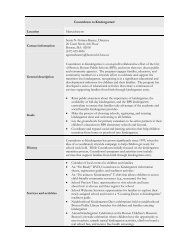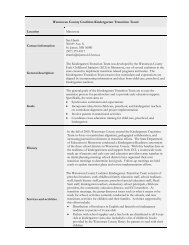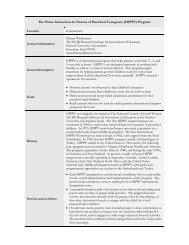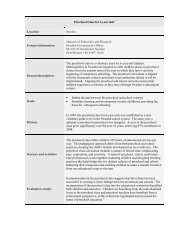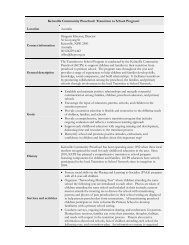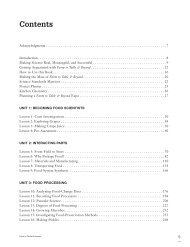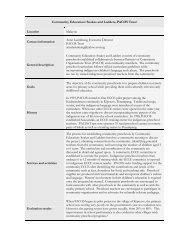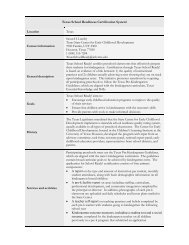Proceedings of the Fourth Annual Teachers College Educational ...
Proceedings of the Fourth Annual Teachers College Educational ...
Proceedings of the Fourth Annual Teachers College Educational ...
You also want an ePaper? Increase the reach of your titles
YUMPU automatically turns print PDFs into web optimized ePapers that Google loves.
Harnessing <strong>the</strong> Power <strong>of</strong> Emotionally Cogent Stimuli for Optimal<br />
Learning<br />
Sydney M. Savion,<br />
George Washington University, 805 21st Street Northwest Washington, DC<br />
Email: ssavion@wmail.gwu.edu<br />
Daniel J. Glisczinski,<br />
University <strong>of</strong> Minnesota Duluth, 1049 University Drive Duluth, MN<br />
Email: dglisczi@d.umn.edu<br />
Abstract: The U.S. market for self-paced e-learning is expected to balloon to $24.2<br />
billion by 2015 (Adkins, 2011). Coupled with <strong>the</strong> torrent <strong>of</strong> mobile devices, which now<br />
outnumber human beings, academia and corporate America stand at a unique<br />
intersection <strong>of</strong> opportunity to engage in best practice instructional design for optimal elearning.<br />
As <strong>the</strong> 21st century market place finds itself in <strong>the</strong> midst <strong>of</strong> a nexus <strong>of</strong> <strong>the</strong> most<br />
connected populace ever, <strong>the</strong> opportunity and perhaps responsibility belongs to <strong>the</strong><br />
learning pr<strong>of</strong>essionals to design neuroscientifically guided, emotionally cogent e-learning<br />
programs, so that <strong>the</strong> most connected populace ever will feel itself moved to cross <strong>the</strong><br />
threshold <strong>of</strong> ubiquitous communication to ubiquitous optimal learning. This paper<br />
proposes when adult learners feel so moved to text, message, and access courses<br />
because <strong>of</strong> <strong>the</strong>ir powerfully moving nature, e-learning will cross <strong>the</strong> threshold <strong>of</strong> program<br />
relevance, and in doing so, mobilize learning through emotionally cogent stimuli.<br />
Corporate America expends an estimated $110 billion annually on employee learning and development<br />
(Rivera & Paradise, 2006). According to a recent report by Ambient Insight market research firm, <strong>the</strong> U.S.<br />
market for self-paced e-learning is expected to balloon to $24.2 billion by 2015 (Adkins, 2011). This taken<br />
toge<strong>the</strong>r with <strong>the</strong> torrent mobile devices in which mobile devices now outnumber human beings, twentyfirst<br />
century corporate education stands at a unique intersection <strong>of</strong> opportunity to engage in best practice<br />
instructional design for optimal e-learning.<br />
Now a days, digital natives (those born into <strong>the</strong> digital age) and digital immigrants (those assimilated to<br />
<strong>the</strong> digital age) alike can be readily observed making use <strong>of</strong> <strong>the</strong>ir mobile devices in <strong>the</strong> bookstore, in <strong>the</strong><br />
fitness center, at <strong>the</strong> cafe, and even in <strong>the</strong> lavatory. While it has become evident that much <strong>of</strong> today’s<br />
experience is bursting with digital interactions. What is less evident, however, is whe<strong>the</strong>r higher education<br />
or corporate America understands enough about cognition to cross over <strong>the</strong> traditional pedagogy<br />
threshold <strong>of</strong> influencing learning to more emotionally cogent stimulating methods that powerfully promote<br />
optimal learning and performance, especially through <strong>the</strong> use <strong>of</strong> mobile devices.<br />
The high degree <strong>of</strong> expenditure on learning and development is not surprising, given its vital role in<br />
maintaining high performance and an effective organization. Interestingly, a substantial amount <strong>of</strong><br />
education and training is designed on <strong>the</strong> premise <strong>of</strong> behaviorism <strong>the</strong>ory, suggesting that learning is<br />
external to <strong>the</strong> individual and that <strong>the</strong> individual is passive in <strong>the</strong> learning process. The <strong>the</strong>ory <strong>of</strong><br />
behaviorism ignores <strong>the</strong> internal aspects <strong>of</strong> learning and fails to genuinely engage <strong>the</strong> learner. This is<br />
significant, given <strong>the</strong> increased distance placed between <strong>the</strong> learner and instructor as a result <strong>of</strong> a<br />
mounting reliance on e-learning pedagogy. And also evidence that only 51% <strong>of</strong> daily adult learning<br />
episodes occur at home or in <strong>the</strong> learner’s natural environment (Vavoula, 2005).<br />
Even as far back as <strong>the</strong> 1900s it was found <strong>the</strong> <strong>the</strong>ory <strong>of</strong> behaviorism had inherent limitations, hence <strong>the</strong><br />
emergence <strong>of</strong> cognitivism. Since <strong>the</strong> seminal works <strong>of</strong> Jean Piaget, cognitive <strong>the</strong>orists have believed that<br />
learning encompasses gradually acquiring and constructing knowledge in which a learner processes and<br />
stores information. Moreover, cognitive psychologists maintain that learning involves <strong>the</strong> use <strong>of</strong> memory,<br />
stimulus and thinking. Now, as we take into account learning in transition via mobile devices,<br />
constructivism emerges as <strong>the</strong> best fit learning <strong>the</strong>ory. Cooper (1993) asserts that learners interpret <strong>the</strong><br />
59



